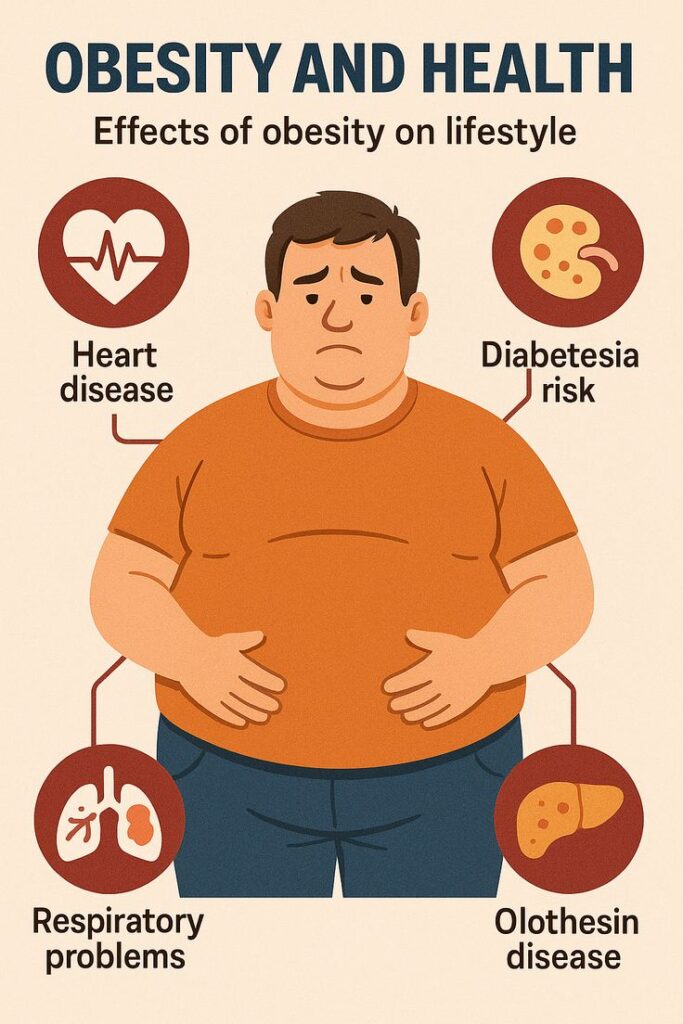
In recent decades, India has witnessed a striking shift in its public health landscape. Once grappling with malnutrition and undernutrition as dominant issues, the country is now facing an unexpected but equally alarming crisis—obesity. While obesity was once considered a problem limited to affluent nations, it has firmly taken root in developing countries like India, with serious implications for public health, the economy, and future generations.
Understanding the Shift
Traditionally, Indian diets were largely plant-based and physically active lifestyles were the norm. However, economic liberalization in the 1990s brought rapid urbanization, increased incomes, and changing lifestyles. Along with these changes came an influx of fast food, processed goods, and sedentary habits.
The National Family Health Survey (NFHS-5), conducted between 2019 and 2021, shows a worrying rise in obesity across all demographics. The survey found that 24% of women and 22.9% of men in India are overweight or obese, up from 20.6% and 18.9% respectively just five years earlier. In urban areas, these numbers are significantly higher, but rural regions are also catching up at an alarming pace.
Causes Behind the Surge
Several interlinked factors contribute to the rise in obesity in India:
- Dietary Changes: The traditional Indian diet has been increasingly replaced by high-calorie, low-nutrient foods. Easy access to processed snacks, sugary drinks, and junk food has led to increased caloric intake without corresponding energy expenditure.
- Sedentary Lifestyle: With more people working desk jobs, commuting long distances, and relying on technology, physical activity has drastically reduced. Screen time among children and adults alike has soared.
- Economic Growth and Urbanization: Higher disposable incomes have changed consumption patterns, particularly in middle- and upper-income groups. Urban environments also offer fewer opportunities for physical exercise, especially in congested cities with limited green spaces.
- Lack of Awareness: Many Indians still perceive obesity as a sign of prosperity and health, particularly in older generations. This cultural mindset can hinder prevention and intervention efforts.
- Genetic Predisposition: South Asians, including Indians, tend to have a higher percentage of body fat and are more prone to central obesity (fat around the abdomen), which increases the risk of metabolic diseases.
Health Consequences

Obesity is not merely a cosmetic concern. It is a major risk factor for non-communicable diseases (NCDs) such as:
- Type 2 diabetes
- Hypertension
- Cardiovascular diseases
- Certain types of cancer
- Sleep apnea
- Osteoarthritis
India is already known as the “diabetes capital of the world”, with over 100 million diabetics as of 2023. A significant proportion of these cases are directly linked to obesity and poor lifestyle habits.
Moreover, childhood obesity is becoming a major concern. Overweight children are more likely to become obese adults, increasing their risk of developing chronic diseases at a younger age and placing long-term strain on the healthcare system.
Economic and Social Impact
The economic burden of obesity is significant. It increases healthcare costs due to the need for ongoing treatment of associated illnesses. Indirect costs include reduced productivity, increased absenteeism, and disability. According to a report by the World Obesity Federation, India could face economic losses of $480 billion by 2060 due to obesity-related health issues.
Obesity also affects quality of life, leading to psychological issues like depression, anxiety, and low self-esteem. In a country where body image and social acceptance are deeply linked, obese individuals often face stigma and discrimination, further worsening their mental health.
What Can Be Done?
Tackling obesity in India requires a multi-pronged and systemic approach. Here are some key strategies:
- Public Awareness Campaigns: Education is crucial. People need to understand the risks associated with obesity and the importance of balanced diets and physical activity.
- School Interventions: Promoting healthy eating and regular exercise among children through curriculum changes, sports initiatives, and banning junk food in schools can create lifelong habits.
- Government Policies: Regulations on food labeling, marketing unhealthy foods (especially to children), and taxing sugary beverages can help reduce consumption of harmful products.
- Urban Planning: Designing cities that promote walking, cycling, and outdoor activities by building parks, bike lanes, and pedestrian-friendly infrastructure.
- Healthcare System Readiness: Training healthcare professionals to detect, counsel, and manage obesity can lead to early interventions and better outcomes.
- Individual Responsibility: Ultimately, individuals must take charge of their health by adopting healthier lifestyles—eating fresh, home-cooked meals, reducing screen time, and including regular physical activity in their routine.
Conclusion
Obesity is a complex, multifactorial issue that is fast becoming one of India’s biggest health threats. Left unchecked, it could undo decades of progress in public health. Combating this silent epidemic will require not just government intervention, but active participation from individuals, families, schools, and communities.
The time to act is now. Through collective effort and sustained awareness, India can reverse the trend and pave the way for a healthier, more resilient future.
